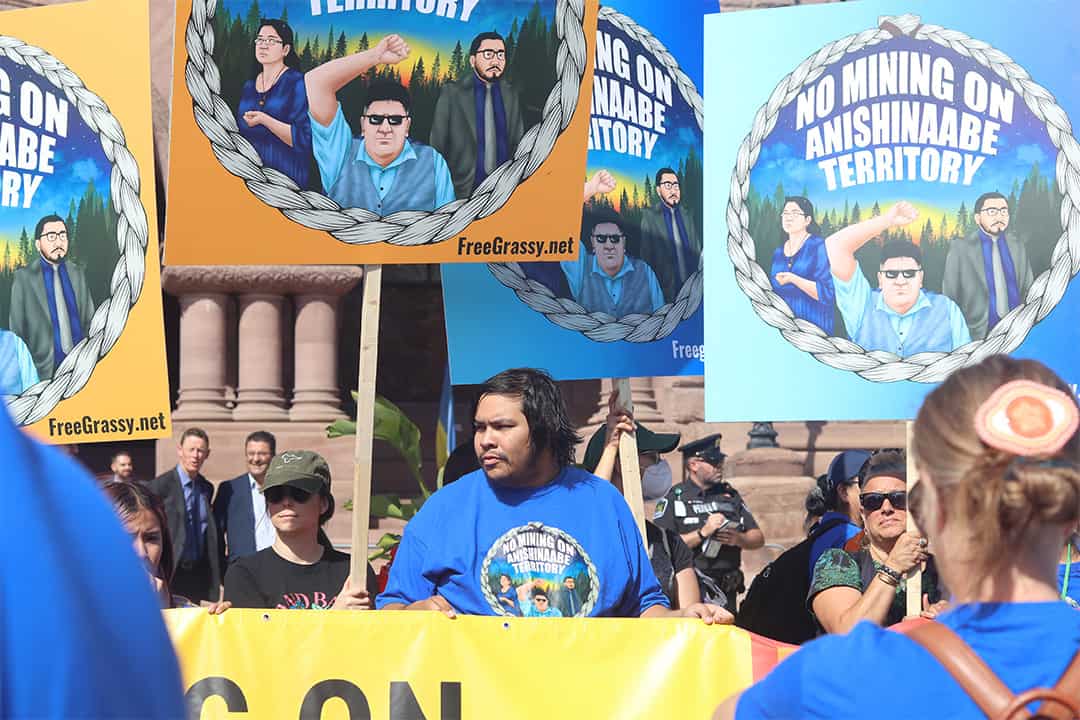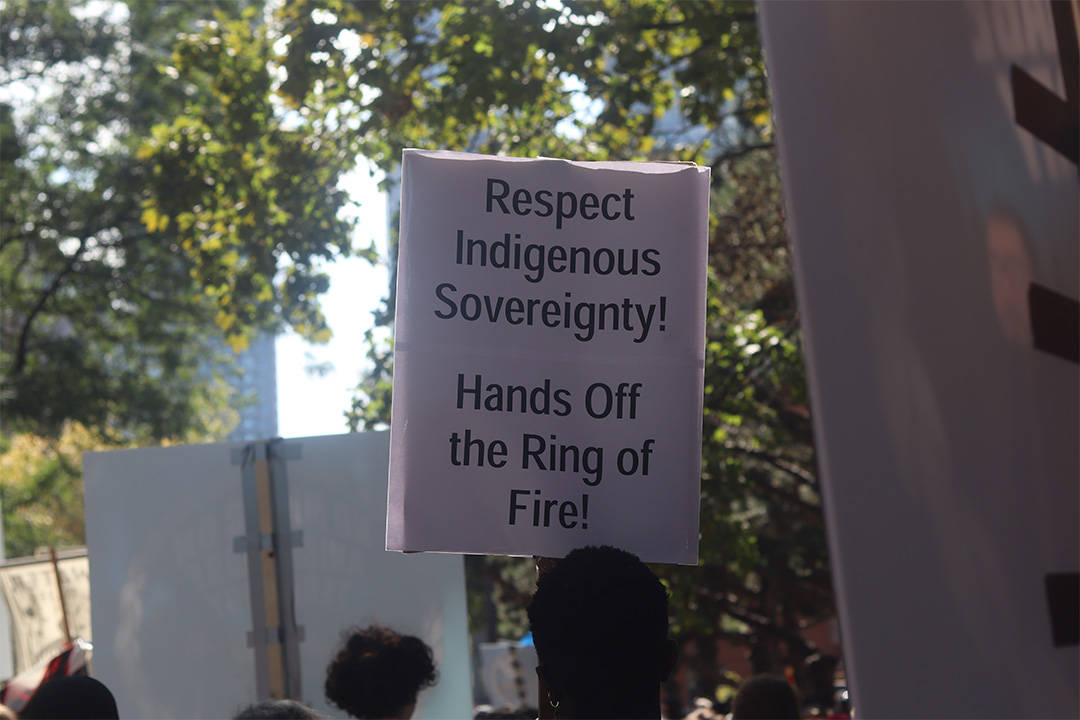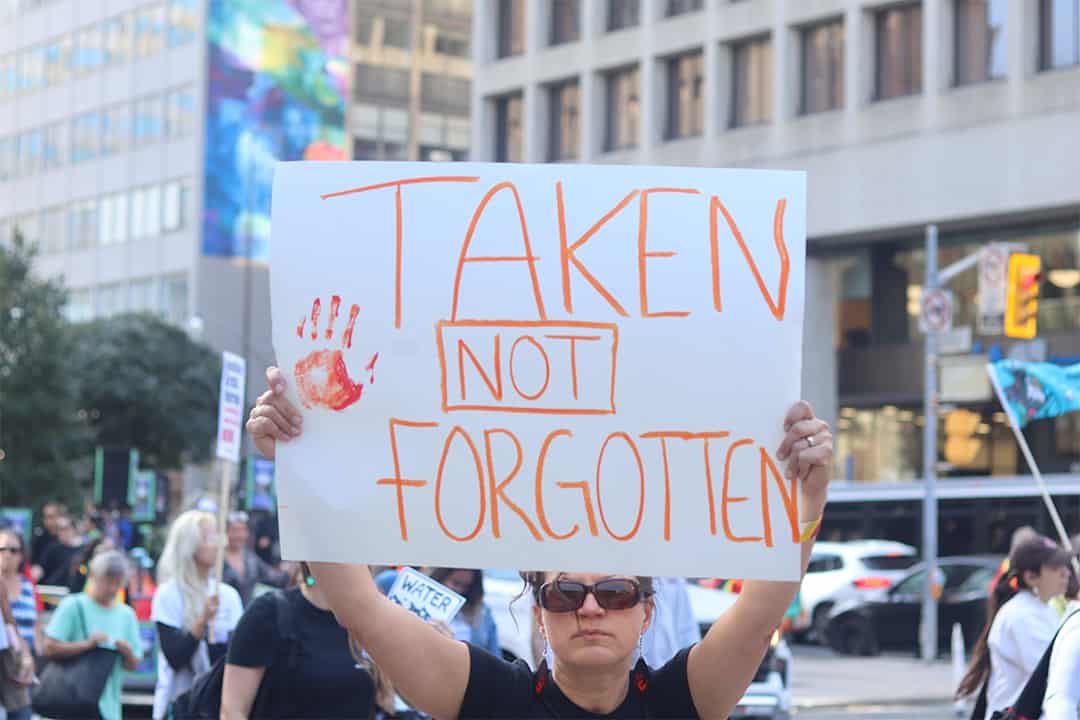Over 6,000 people protested against the Ontario government’s policies allowing companies to mine on some First Nations’ traditional lands as part of the March for the Land, which took place in Toronto on September 27.
The First Nations Land Defence Alliance — a group that includes members of Kitchenuhmaykoosib Inninuwug (KI) First Nation, Wapekeka First Nation, Neskantaga First Nation, Asubpeeschoseewagong First Nation, and Muskrat Dam First Nation, created to fight against government intrusion on their land — organized the protest. The 1906 Treaty 9 allocates these First Nations over 60,000 square feet of land, but resource extraction companies have tried to mine on these lands.
The protesters criticized Premier Doug Ford’s “free entry” mining system, which allows companies to apply to mine on land in Ontario — including on the land of some First Nations — without ever travelling there physically. The Land Defence Alliance has argued that the system makes it easier for mining companies to make claims on their territories for mineral exploration without their consent.
Many U of T students attended the protest, and over 30 organizations, including Climate Justice UofT, the Ontario Secondary School Teacher Federation, and Toronto Indigenous Harm Reduction, supported the protest.
The protest
The march started at noon in Grange Park, where protesters gathered for speeches.
Stanley Anderson — the deputy chief of Wapekeka First Nation — called on the government to stop mining on Wapekeka land. “We want to enjoy the land that was given to us,” Anderson said. “We continue what was given to us, what the Creator gave us, and the purpose.”
Treaty 9 is an agreement signed by representatives from some Cree and Anishinaabe communities and the government in 1906, about territory covering about two-thirds of Ontario’s land mass. The Treaty, as it was written, allowed the Crown to take control of the land for purposes such as mining, trade, and travelling. The treaty also acknowledged the rights of Indigenous peoples on the land to continue pursuing traditional ways of hunting, fishing, and trapping subject to federal laws. However, it allowed the colonial government to regulate and bar Indigenous peoples’ use of land settlers wanted for economic activity.
The Narwhal has reported that Treaty 9’s full terms were not translated to Cree or Anishinaabemowin, and government officials did not accurately record in writing what they decided on in oral agreements with Indigenous leaders.
In April 2023, leaders and chiefs from Treaty 9 territory announced that they had launched a lawsuit to “fundamentally change the way resource and land management decisions are made in the region.” This lawsuit responded to Premier Doug Ford’s proposed “critical minerals” strategy, which plans to mine in the “Ring of Fire” — an area with deposits of minerals, such as nickel, cobalt, and lithium, located on lands granted to First Nations in Treaty 9. The premier’s goal was to increase the supply of these minerals, which go into technologies such as smartphones, laptops, and electric vehicles.
Many speakers at the protest expressed their anger with the Ford government, demanding that no development activities occur on land granted to them in Treaty 9 without freely given and informed prior consent.
According to an article from CP24, several leaders from First Nations with land in the Ring of Fire demanded to meet with Ford about the mining activities on their land before the protest, but he refused the request. Greg Rickford, the Minister of Indigenous Affairs of Ontario, offered to meet instead.
In a speech at the protest, Sam Mckay — a councillor for KI — addressed Ford: “If you want to talk to us, you come and talk to us.”
In response to an email from The Varsity asking whether Ford or the Ontario government have met with the First Nations’ leaders to discuss their concerns about mining, a spokesperson from the Ministry of Mines wrote that “Ontario is building relationships with Indigenous partners that revolve around fairness and respect.” In addition, the spokesperson noted that the government follows their constitutional duty to consult with First Nations.
After the speeches, the protesters began marching; some sang or played drums, while others yelled chants such as “The people united will never be defeated” and “Stand up, fight back.” Around 3:00 pm, the protesters arrived at the south side of Queens Park, in front of Ontario’s Legislative Building. Protesters performed a drumming ceremony, sang, and heard speeches.
As of October 19, the Ontario government has not publicly announced a meeting between the five First Nations leaders and Ford.
The free entry system
Protesters also criticized Ontario’s free entry mining system.
According to the report Mining in Ontario: A Deeper Look, the “free entry system” is a part of Ontario’s Mining Act that allows companies to “stake a claim” to conduct resource extraction on any area of “open crown land” — including privately-owned and traditional Indigenous lands — if the companies see a significant potential in minerals. A company’s claim gives them the exclusive right to investigate the land for potential mining opportunities and then use it for mining operations.
In 2009, the Ontario provincial government made changes to its Mining Act in an effort to modernize the amendment to follow section 35 of the Constitution Act of 1982, which affirms Indigenous peoples’ rights to occupy and use the land and resources and the government’s duty to consult and accommodate Indigenous peoples.
However, a 2020 paper by Martin-Joe Ezeudu — an assistant professor at Bora Laskin Faculty of Law at Lakehead University who previously worked at the Ontario Ministry of the Attorney General — argues that the act is still unconstitutional because the free-entry mining system still allows companies to stake a claim without consulting Indigenous people.
Student involvement
U of T students, labour unions, and other groups attended the march. In a speech, March for the Land organizers thanked Climate Justice UofT for being one of the organizations that provided support for the march.
In an email to The Varsity, Amy Mann, a third-year student studying health studies and math and co-coordinator for Climate Justice UofT, noted that the climate crisis disproportionately impacts Indigenous communities. She wrote that students must show up in solidarity and follow Indigenous peoples’ lead in fighting for climate justice and decolonization.
Amanda Meng and Ave Thomson, two second-year students both studying peace, conflict, and justice studies, also shared similar sentiments. Meng — who is also studying environmental studies and environmental science — told The Varsity that she hoped the protest showed how settlers need to help Indigenous peoples protect their rights.
Thomson said she hopes the protest encourages people to recognize the importance of advocating for Indigenous peoples’ rights, and how such advocacy addresses all peoples’ needs. “It is very important to recognize how [these mining policies are] disproportionately impacting [Indigenous peoples], but overall, it is important to recognize all of these things [are] for the greater good for everyone,” she said.




